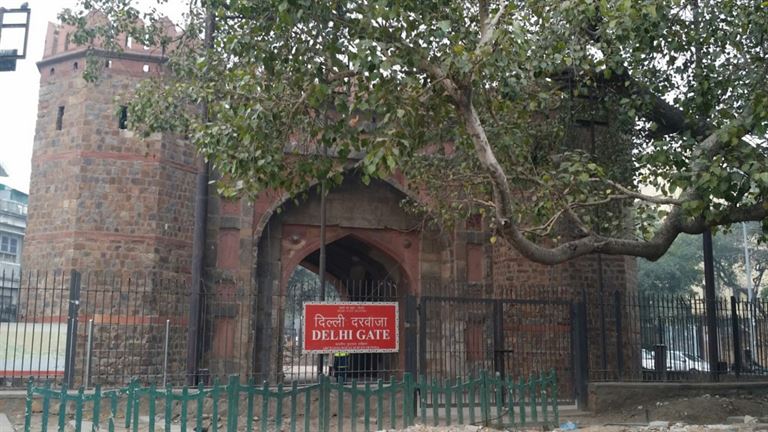
(Shahjahanabad Delhi Gate)
Shahjahanabad, the seventh city of Delhi, was built by Shah Jahan in 1649 like a fortress encircled by strong and high red–brick walls with 14 entry gates to the city, in addition to 16 wicket gates called khirkis. They were named according to the cities they were on the route of or after some famous personality like Shah Turkman. The gates were known as Dilli Darwaza (also known as Delhi Gate), Kabuli Darwaza, Raj Ghat Darwaza, Khizri Darwaza, Nigambodh Darwaza, Kela ke Ghat ka Darwaza, Lal Darwaza, Kashmiri Darwaza, Badar Darwaza, Patthar Khati Darwaza, Lahori Darwaza, Ajmeri Darwaza and Turkuman Darwaza.
There are two Delhi Gates. One in the walls of Red Fort itself and one which was in the walled city of Shahjahanabad.
(Shahjahanabad Delhi Gate)
Both the Delhi Gate is so called because it faces the other older cities . The one in Red Fort was renamed Alexandra Gate under the British.
According to Maulvi Zafar Hasan the one in Red Fort had two stone elephants standing at either side of the entrance arch but they dont exist today. These elephants were replaced in 1903 by Lord Curzon as a substitute for the original ones. The original had riders who were said to be the Rajput warriors Jaimal and Patta but it is more probable they were ordinary mahouts. As Aurangzeb did not approve of statues he is said to have had them demolished and nothing was heard of them till 1863 when according to Maulvi Zafar Hasan some 125 fragments of the original statues were found buried in the Red Fort. Three years later the elephant statues were reconstructed and set up in the Queen’s Park.
Note:
The one with elephants is Red Fort Delhi Gate. It wass also called Haathi Gate.
“Delhi Gate, finest in Delhi,” 1908 from Ames Library
(Red Fort Delhi Gate)
New statues were made by Indian workmen under supervision & design of Mr. R W Mackenzie an artist with experience of Indian art. The older ones were so mutilated they could not be restored.
(Red Fort Delhi Gate)
Bernier has described these statues on the side of Delhi Gate.
Alexander Cunningham said that these elephants stood outside Agra Fort and were brought from there to Delhi.
Photograph by Beglar of the original restored elephant from the 1870s. Source British Library (shelfmark 1003/(877)
The emperor used this gate in Red Fort to go to the Jama Masjid for prayer. This gate is similar in design to the Lahore Gate. It is in the south west corner of the Red Fort.
Aurangzeb had the battlements removed and the tops of the walls covered with earth for purposes of defense. He built barbicans in front of Lahore Gate and Delhi Gate. The barbican of the Delhi Gate was entered from the west wall of the Lahore Gate. It is recorded that when Shah Jahan wrote to his son from prison at Agra and said to him of these barbicans, “You have made the Fort a bride and set a veil before her face.” ( Maulvi Zafar Hasan)
Barbican in front of Lahori Gate. Red Fort at Delhi [Lahori Gate]; from ‘Amal-i Salih, by Muhammad Salih Kanbu, 1700’s: British Museum
Note : A barbican is a fortified outpost or gateway, such as an outer defense to a city or castle, or any tower situated over a gate or bridge which was used for defensive purposes.
Today gate in the Shahjahanabad wall stands alone and is fenced in but the guard allowed me to enter.
(Shahjahanabad Delhi Gate)
(Shahjahanabad Delhi Gate)
There is some of the original stone decorations still existing.
(Shahjahanabad Delhi Gate)
There was a homeless man sheltering in one of the niches on the outside walk of the gate
(Shahjahanabad Delhi Gate)
Today’s horsepower and warriors.
A map of Lal Qila from Stephen Carr’s book on Delhi. (The Delhi Gate is on the top in the middle)
Location: middle of the road, at the end of Netaji Subhash Chandra Road (or Netaji Subhash Marg), at the edge of the Daryaganj.

